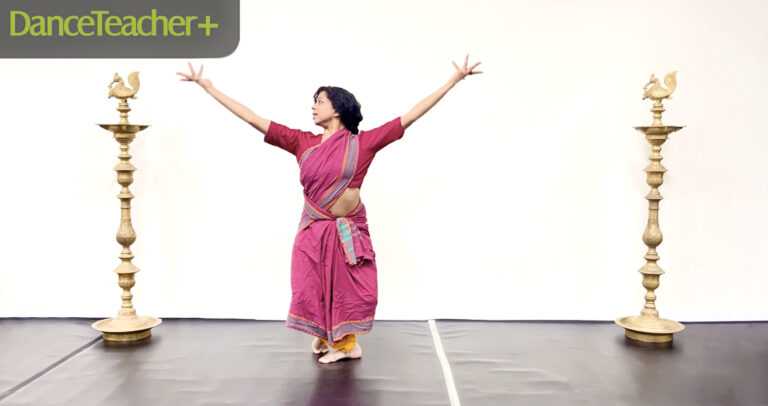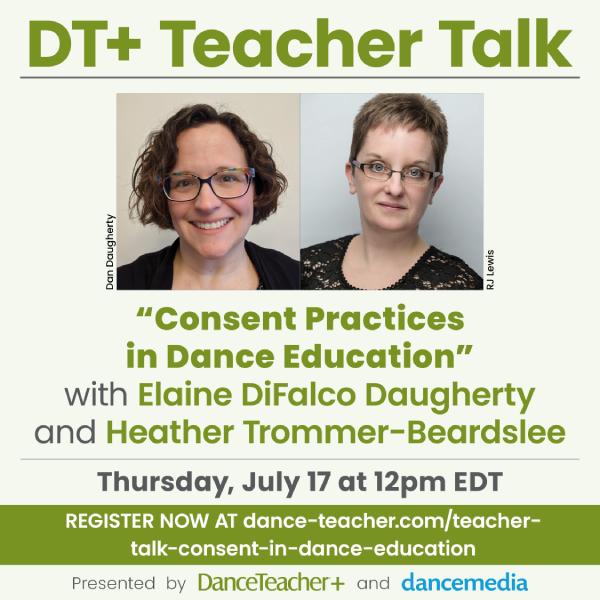Mentoring for new K–12 dance teachers
Susan Rainey with her PS 122 middle school students
This month, plenty of new K–12 dance teachers will anxiously make their classroom debuts. Susan Rainey, who starts her third year as a full-time dance teacher at PS 122 middle school in Queens this fall, remembers her first-day jitters all too well. But thanks to a New York City Department of Education mentoring program, she’s had plenty of backstage support and peer guidance during her early years—even though she’s the only dance teacher in her school.
The Arnhold New Dance Teacher Support Program was established two years ago by Joan Finkelstein, director of dance at the New York City Department of Education, and Jody Arnhold, who co-founded the Dance Education Laboratory at the 92nd Street Y Harkness Dance Center with Finkelstein. The program, offered to all of the city’s new dance teachers, pairs seasoned teachers with those just starting out. “The first or second year for any teacher is challenging,” says Finkelstein. “But it’s particularly challenging for teachers of dance. Often they are the only ones in the building who are teaching that content area.” Having a mentor eases the transition from student to full-time teacher and provides practical advice that only years of experience in a public school dance classroom can provide. “It’s so hard to begin. It’s important to have help and to have someone to talk to,” says Arnhold.
Funded by The Arnhold Foundation, the program provides first- and second-year dance teachers with three classroom visits followed by assessment sessions. The visits are spaced throughout the school year so that teachers have time to implement their mentor’s suggestions effectively. Each teacher also receives a toolkit of materials, including books, DVDs and dance-motif notation cards.
To help launch and enhance the new teacher’s program, the school also receives a stipend that can be used to purchase additional materials, sign up for professional development workshops, bring in guest artists or take students to a concert. So far the program has served 27 new teachers and currently has four mentors (including Arnhold), all of whom are seasoned dance educators with years of experience and wisdom to share.
Of the many challenges that new teachers face, classroom management often ranks at the top of the list. “New dance teachers have so much theory, but it’s kind of a shock to be in your own classroom,” says Arnhold, where there are all sorts of practical matters that can throw a new teacher off. “How do you get kids in and out of the classroom? Where do their shoes and socks go? Who should not sit next to each other? Mentors can help with these simple strategies, which are really not so simple,” says Arnhold.
One of the four mentors is Mary Barnett, whose long history in the field includes professional work with the Alvin Ailey, Martha Graham and Lar Lubovitch companies, as well as 12 years of teaching at Talent Unlimited High School in Manhattan. “Ninety-nine percent of the time, I hear that discipline is a problem,” Barnett says. “After I observe the class, however, I find that it’s very seldom a real discipline problem. It’s actually an organizational problem.” As a mentor, she helps new teachers refine their class design in ways that draw students in and keep them engaged, thus reducing the need for discipline.
“Mary really helped me structure my classes—from the warm-up, to the theme for the day, to the culminating activity,” says Rainey. “She helped me figure out exactly what it was that I wanted to introduce and have students know by the end of each unit. Before Mary’s visits, I was trying to do too much in too short an amount of time.” But based on Barnett’s advice, Rainey reduced the number of units she had originally planned and doubled the time she spent exploring the material of the remaining units. “I made the units longer so I could get more accomplished within each one and the kids would have more time to absorb the information. In a sense, I’m doing more by doing less,” she says.
One of Rainey’s goals in restructuring her lessons was to put greater focus on technique. Since some of her students had no dance experience, she had been fearful of demanding too much from them. She had begun the year with an improvisational warm-up instead of a series of set exercises. “I would call out different ways to move across the floor, but I didn’t incorporate technique,” says Rainey. Barnett and Rainey devised a warm-up combining ballet exercises with Horton technique. Barnett also encouraged Rainey to identify specific technical skills for each unit and to build those skills into her class from the warm-up through the floor exercises and into student choreography projects. “Many of my students had difficulty pointing their feet in passé, for example. So, during the warm-up, we’d start with a plié and then have them point their foot at the ankle and then bring their foot up to the knee. After practicing that a few times, we’d develop it further by adding a passé relevé,” Rainey explains. “Later in class, we’d work on spotting and turning by practicing plié passé in four directions, followed by plié relevé in four directions, and, finally, by a plié into a passé turn.”
Rainey found that her students were excited about incorporating new technical skills into their own choreography and that their overall attitude improved. “They liked the challenge of learning technique. It kept them engaged and better behaved because they were focusing on something specific that enhanced them and made them better dancers,” Rainey says. “Students like being successful and I think they felt successful in my class.”
As a result of her mentorship, Rainey is starting the new school year with clear objectives for her students and a better sense of how to design engaging units. “I definitely feel more confident about my classroom management skills and the quality of education that I’m offering,” she says. “I know that my students are walking away with something—whether it is stronger technique or simply a feeling of being more comfortable in their bodies and more confident in themselves.” DT
Darrah Carr is a New York–based choreographer, educator and writer active in both the Irish and modern dance communities.
Photo by Donnelly Marks, courtesy of Susan Rainey




